|
aggradation
aggradational parasequence set
basin-floor fan
early lowstand systems tract
falling stage systems tract
highstand systems tract
late lowstand systems tract
lowstand wedge
type 1 sequence boundary
type 2 sequence boundary
transgressive systems tract
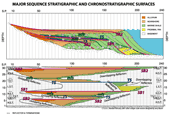
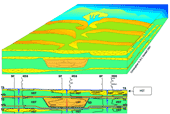


|
Throughout this web site it is proposed that the lowstand systems tract is bounded by the falling stage systems tract and the transgressive systems tract (Plint and Nummedal, 2000; Coe et al, 2002). This system tract is represented by the sedimentary accumulation that straddles the lowest position of the relative sea level curve. It often forms a prograding wedge at the base of a shelf margin with its lower boundary onlapping onto the prograding clinoforms (see animated gif) and/or downlapping onto a downslope fan. The stacking patterns of parasequences of the lowstand systems tract exhibit backstepping onlapping retrogradational aggrading clinoforms that thicken updip capturing the effect of the rate of rise in relative sea level is greater than the rate sediment accumulation. This change in sediment geometry can be explained as occurring when accommodation starts to expand in response to a relative rise in sea level that occurs when a rise eustasy exceeds the rate of subsidence.
The upper boundary of the lowstand systems tract is marked by the development of the transgressive surface that steps up onto the shelf margin (see animated gif). The characterization of the boundary between falling stage systems tract (Plint and Nummendal, 2000) , or the early lowstand systems tract (Posamentier and Allen, 1999), and the overlying sediments becomes "fuzzy" if the onlapping wedge of the lowstand systems tract fills incised valleys and becomes subaerial. The depositional setting of this onlapping lowstand systems tract wedge occurs below the shelf margin break, the depth of water in the adjacent basin determines whether the sediments are subaerial, and/or submarine. This subaerial onlap might be equated by some with the transgressive systems tract. On this web site these latter onlapping strata are only referred to as a part of the transgressive systems tract when they rise above the shelf break. It is recognized that in outcrop and wells it may be nearly impossible to determine if this onlapping occurs below or above the shelf margin break. This onlap of fluvial and coastal plain deposits has been defined as "coastal" onlap by Mitchum (1977).
Posamentier and Allen (1999) refer to the lowstand systems tract defined above as the late lowstand systems tract. They refer to the falling stage systems tract as the early lowstand systems tract. Traditionally the sediments of the lowstand systems tract, as defined by Posamentier and Allen (1999), included the deposits that accumulated after the onset of relative sea-level fall directly on the sequence boundary over the highstand systems tract as a basin-floor fan, slope fan, and lowstand wedge. As can be recognized on this web site, this "old lowstand systems tract" is now divided into the falling stage systems tract with its basin-floor fans, and slope fans while, as indicated above, the lowstand systems tract sediments now form lowstand wedges. These latter often filling incised valleys that cut down into the highstand systems tract. This systems tract is equated with development of limited accommodation associated with a small rise relative rise sea level during an essentially lowstand of the sea.


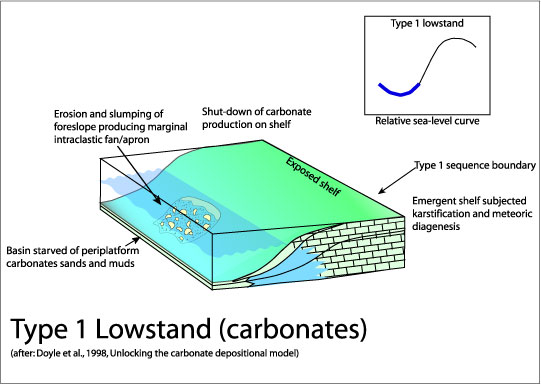
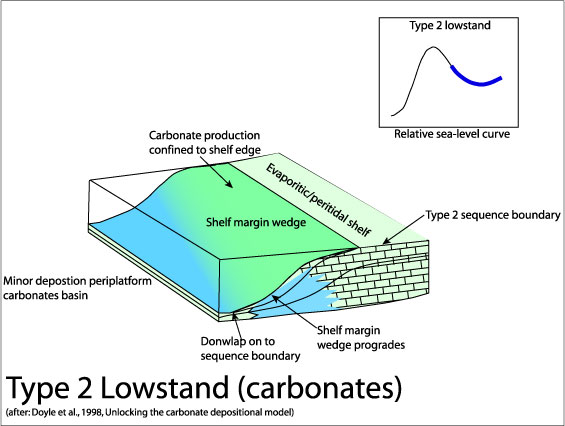
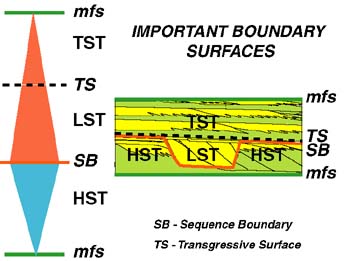
References
Coe, Angela L.,(Ed) 2002, The Sedimentary Record of Sea Level Change, Cambridge University Press 288 pp.
Mitchum Jr., R. M., (1977), Seismic Stratigraphy and Global Changes of Sea Level: Part 11. Glossary of Terms used in Seismic Stratigraphy: Section 2. Application of Seismic Reflection Configuration to Stratigraphic Interpretation, Memoir 26 Pages 205 - 212.
Plint, A.G., Nummedal, D., 2000, The falling stage systems tract: recognition and importance in sequence stratigraphic analysis. In: Hunt, D., Gawthorpe, R.L. (Eds.), Sedimentary Response to forced regression, vol. 172. Geol. Soc. London Speci. Publ, pp. 1–17.
Posamentier, H.W., Jervey, M.T., Vail, P.R., 1988, eustatic controls on clastic deposition. I. Conceptual framework. In: Wilgus, C.K., Hastings, B.S., Kendall, C.G.St.C., Posamentier, H.W., Ross, C.A., Van Wagoner, J.C. (Eds.), Sea Level Changes––An Integrated Approach, vol. 42. SEPM Special Publication, pp. 110– 124.
|